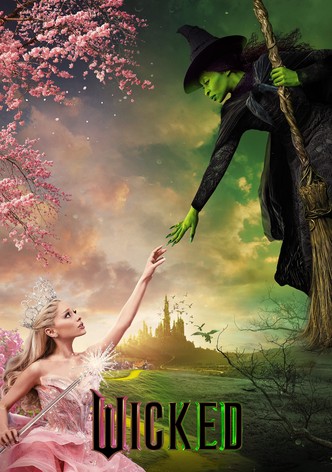It’s time, once more, to hold space for Wicked, as the Oz-set sequel For Good flies into cinemas a year after Part One. IRL BFFs Cynthia Erivo and Ariana Grande are back as Elpheba and Glinda, the so-called Wicked Witch of the West and Good Witch (of a non-disclosed direction), along with the rest of the main cast, including Michelle Yeoh as Madam Morrible and Jeff Goldblum as the Wizard, who, by the end of the first film, declared Elpheba public enemy number one, having already scapegoated Oz’s talking animals as similar pariahs.
Sadly, as is so often the case with prequels, there’s only so much Elphepha can do to try and escape this public perception and her prewritten fate – to be melted by a doe-eyed, Kansas teenager with a bucket of water on the orders of a charlatan. But Wicked: For Good has a twist ending that gives Elpheba a more hopeful and mysterious fate. Let’s unpack what happens and why.
What Happens to Elpheba In Wicked: For Good
Wicked: For Good picks up some time after Elpheba steals the Grimmerie, a book of spells that only she can read, from the Wizard’s castle in the Emerald City. Having refused to help the Wizard and Madame Morrible use its magic to subjugate Oz, she becomes a lone freedom fighter seeking to expose the Wizard as a fraud.
Glinda, meanwhile, dejectedly becomes the poster child for ‘good’ despite a lack of tangible powers, with Morrible’s propaganda establishing a dichotomy between her and Elpheba – one a hero of the people and the other something for them to unite against. She also gets engaged to Prince Fiyero, played by a frosted-tipped Jonathan Bailey – a move that’s also a PR stunt, even though Glinda’s feelings for him are real.
This culminates in a confrontation at the Wizard’s castle, where Elpheba implores him to tell the people of Oz that he’s been manipulating them. With the help of Glinda, he instead brokers a truce with her. However, as Glinda and Fiyero prepare to wed, Elpheba discovers the Wizard has been imprisoning the animals. Enraged, she frees and unleashes them on him, ruining the wedding, and giving Fiyero the impetus to leave with her.
This moment of respite is short-lived, however, when Dorothy crash-lands in Oz, thanks to a vengeful tornado conjured by Morrible. Fiyero is captured by the Emerald Guard and tortured in an effort to reveal Elpheba’s base of operations (her Western castle). Desperate to spare him, she transforms him into the Scarecrow, and embraces her characterisation as ‘wicked’, meeting with Glinda one last time to encourage her to also truly be good, before facing her untimely demise at the hands of Dorothy.
How Elpheba Cheats Death In Wicked (Without Changing The Wizard of Oz)
As fans of the original book and musical will already know, the Wicked Witch of the West isn’t actually killed when Dorothy chucks a bucket of water over her. Wicked teases this key weakness long before this happens at the climax of For Good – when Morrible shields Elpheba from the rain in Part One, for instance. But after Dorothy triumphantly takes her broomstick, as proof of her death, to the Wizard, and Glinda, who witnessed the whole thing from a hiding place, tearfully returns to take up her goodly duties in the Emerald City, we return to the Wicked Witch’s castle.
Fiyero, in scarecrow form, opens a hidden trap door, revealing Elpheba slipped through it to fake her death. It seems the whole water thing was just a myth all along, propaganda that Elpheba used to her advantage in the end. Having chosen to martyr herself for the sake of maintaining the new equilibrium, she leaves Oz altogether with Fiyero. They’re last seen journeying through a mysterious desert that exists outside of it.
What Is the ‘Deadly Desert’?
Also known as the ‘impasable desert’, the ‘deadly desert’ that Elpheba and Fiyero end up in comes from L. Frank Baum’s original Oz books, the lore of which many of the adaptations only really scratch the surface of. In Wicked, the desert’s existence is established in the first act of For Good when Elpheba sees the animals fleeing persecution through a tunnel to it.
This desert surrounds the land of Oz, and as the name implies, it can be lethal for anyone passing through it. As per the Oz novels: "Any living thing that touches it turns to sand." In the 1939 movie, Oz is one big fever dream in Dorothy’s head. However, in Baum’s lore, Oz is real and exists in our world – the desert not only makes it difficult for anyone to leave Oz, but for anyone on the outside to wander in. That’s why outsiders like Dorothy and the Wizard can only get there via air travel. (Baum published the first Oz book in 1900, just before the invention of planes, so he wouldn’t have considered the implications of random commercial flights drifting into Ozian airspace every day…)
Why Wicked Had to (Partially) Change The Wizard of Oz’s Ending
The more Wicked: For Good overlaps with The Wizard of Oz, the more hoops it has to jump through to both preserve the beloved film’s central story while keeping its own narrative interesting – and the payoff satisfying.
Elpheba has to be ‘killed’ by Dorothy to uphold the core canon, but that’s a pretty downer ending after we’ve spent around four hours across two movies sympathising with and rooting for her. Tragedy isn’t out of place for major stage musicals, like Les Misérables and The Phantom of the Opera, but in this case, Elpheba dying for real may have been both too bleak and too predictable. By having her fake her death and leave Oz, the original Wizard of Oz ending remains intact, and Wicked can deliver one final surprise to audiences.
It also allows Elpheba to finally take control of the narrative. Wicked is a big, shiny musical that looks sweet on its surface, but has a more sobering message about propaganda, fear, and control barely concealed underneath. Elphaba is mischaracterised to the public throughout the films as an evil force that must be purged. In the end, if she’d died for real, it would have looked like she gave up, closing things out on a note of hopelessness. By orchestrating her own demise and selflessly choosing her fate, Elpheba instead regains her autonomy and leaves Oz in a better, more equitable state.













































































































































































